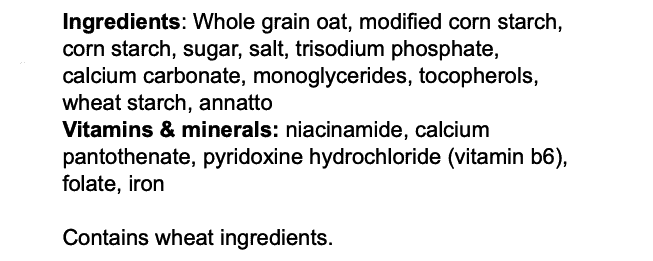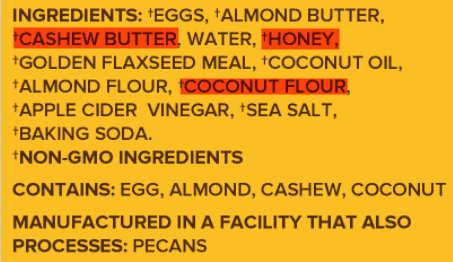


Find foods you can eat.
Low FODMAP Label Reading
Published on June 2, 2021While it’s always the safest bet to eat certified low FODMAP foods when following a low FODMAP elimination diet, it’s not possible to do so all the time due to the limited number of certified products. There are thousands of untested foods throughout the world, so how can you improve your low FODMAP label reading to look at a label and determine if a food is high or low FODMAP?
Fortunately, the Fig app takes out much of this guesswork, so it has never been easier to identify foods that fit your unique dietary needs and preferences. But even with the best technology in your hands, it’s still helpful to have a basic understanding of what to look for on food labels. Below are some tips for reading labels to figure out if a food is likely high or low FODMAP. We can never be 100% certain on FODMAP status without lab testing, so in many cases we must make our best educated guess.
Low FODMAP Label Reading 101
It is important to note that ingredients are listed in descending order based on their weight. This means that ingredients listed first are found in a higher proportion in a food product and ingredients listed last are found in a smaller proportion. For example, check out this label below:

Here you can see that the first ingredient is “whole grain oat,” so oat is the most prevalent ingredient in this product. Iron is last, so there is less iron than anything else in this particular product. Vitamins and minerals like iron are often added to fortify foods but are not FODMAPs. Wheat starch is thought to be low FODMAP due to processing, especially in a very small portion. Based on all of the above, this product is likely to be low FODMAP, but because rolled oats have a low FODMAP serving size of ½ cup, limit this to ½ cup serving and monitor tolerance.
Do you need to worry about Allergen Statements for FODMAPs?
Unless you have a true allergy to an ingredient, you don’t need to worry about whether a food is manufactured on the same equipment as high FODMAP foods. Wheat is declared on this label above, so someone with celiac disease would want to avoid this product, but someone with an intolerance to the FODMAP in wheat (fructans) is unlikely to react to this trace amount.
How can you tell if a food is Low FODMAP or High FODMAP?
Check the label for the presence of any obvious high FODMAP foods, particularly in the beginning of the ingredient list.
FODMAPs are portion sensitive, and some foods are low FODMAP only in very small portions. For instance, both honey and agave have small low FODMAP serving sizes of just 1 teaspoon, so if these foods are listed towards the end of the ingredient string, it means they are only found in that product in a very small amount, and are therefore unlikely to trigger symptoms.
Using that same example, if a food lists honey or agave as the first or second ingredient, it occurs in a larger amount and should be avoided during the elimination phase. Additionally, if you see high FODMAP foods which have no low FODMAP serving size, such as garlic, onion, pears, etc, you should avoid that product.
Remember that FODMAPs are carbohydrates, so if a food doesn’t fit into that category, it is not a FODMAP.
Protein foods (like meat, chicken and fish), fats, vitamins and minerals are not carbohydrates, and therefore they are not FODMAPs. The majority of preservatives are not FODMAPs. High FODMAP foods used as food coloring, such as beet root, are likely low FODMAP because such a tiny amount is used for coloring.
Use the “2% or less” rule.
Here at FIG, we go by the rule that if a high FODMAP ingredient or an untested ingredient is listed as “less than 2%” on the label, it is very unlikely to trigger symptoms. Less than 2% is a tiny amount in any recipe. An exception to this “2% or less” rule may be garlic, garlic powder, onion, onion powder, and chicory root / inulin. Avoiding these ingredients while on the initial low FODMAP elimination phase is typically recommended. Of course, there are always individuals who are very sensitive or have an allergy to certain ingredients.
When in doubt, skip that product.
If you’re not sure about the FODMAP status of a particular product, it’s best to err on the side of caution. You can always try it later on once out of the elimination phase and when symptoms are settled.
Whenever possible, it’s best to consume mostly whole foods and to minimize processed foods.
While we all need to supplement with some premade foods for convenience, they shouldn’t make up the majority of our diets. Whole foods like fruits and vegetables are easy to determine FODMAP content for—just check the Monash app for safe serving sizes.
List of Low FODMAP Ingredients
Listed below are some common ingredients that are likely to be low FODMAP in the US. Note that this list is by no means exhaustive and is not a commentary about their nutritional value, but simply their likely FODMAP status. For a full list of low FODMAP ingredients, check the Fig app.
- Arrowroot flour
- Brown cane sugar
- Buckwheat flour
- Butter
- Cane sugar
- Cellulose
- Colorings including Red 40, Yellow 5 and Yellow 6
- Corn flour
- Corn syrup
- Enzymes
- Green banana flour
- Gums; including acacia, carrageenan, locust bean, gellan, guar, and xanthan
- Maize flour
- Margarine
- Milk fat
- Millet flour
- Preservatives; including BHT, BHA, nitrates, sodium benzoate, potassium benzoate, benzene
- Oils including; peanut, vegetable, canola, olive, soy, and coconut
- Proteins; including poultry, fish, eggs, meats, seafood
- Quinoa flour
- Rice; basmati, brown, white
- Rice flour
- Salt
- Sorghum flour
- Soy lecithin
- Spices
- Teff flour
- Vanilla extract
- Vitamins and minerals, including antioxidants
- Yeast
List of High FODMAP Ingredients
It is best to avoid the following ingredients if they are found towards the beginning of the ingredient list. Again, consider the placement in the ingredient list for foods with a small low FODMAP serving size such as apples or honey, which are likely safe when listed at the end of a label. Refer to the Monash app for more details on FODMAPs in foods and portion sizes. For a full list of high FODMAP ingredients, check the Fig app.
- Agave
- Amaranth flour
- Apple
- Apricot
- Blackberry
- Barley flour
- Cauliflower
- Celery
- Cherry and cherry juice
- Chili, ancho
- Chicory Root or inulin
- Coconut flour
- Dried fruits; apple, dates, fig, mango, paw paw, pear, pineapple
- Fructose
- Fructooligosaccharides (FOS)
- Fruit juice concentrates; especially apple, peach, or pear
- Garlic
- Garlic powder
- High fructose corn syrup
- Honey
- Isomalt
- Lactose
- Leek bulbs
- Maltitol
- Mango
- Milk
- Molasses
- Mushrooms; button, enoki, porcini (dried), portobello, shiitake, black chanterelle (dried)
- Natural flavorings (may include garlic and onion)
- Onion
- Onion powder
- Pear
- Rye flour
- Shallot
- Sorbitol
- Soy flour
- Wheat flour
- Xylitol
High FODMAP Label Example
Many paleo and gluten-free breads are made with high FODMAP ingredients, so we can’t assume that gluten-free foods are low FODMAP. Check out this label for Base Culture paleo and gluten-free bread below. This is what we would call a “FODMAP bomb,” because it has so many high FODMAP ingredients!

Honey is relatively high up on the ingredient list, so there may be more than a teaspoon serving size, and both cashew butter and coconut flour are high FODMAP at any portion. Additionally, almond butter and almond flour both have a relatively small low FODMAP serving size, so you’d want to use caution with these ingredients and avoid foods where they are listed first. With all these combined, this is a high FODMAP gluten-free bread that you’d want to avoid on a low FODMAP elimination diet.
Low FODMAP Label Reading Example
This is from Tate’s gluten free chocolate chip cookies. Happily, all of these ingredients are low FODMAP, making this product suitable for a low FODMAP diet.

In Summary
Always be sure to check food labels and take note of the order in which foods are added to determine if the product is likely to be high or low FODMAP. When in doubt, skip that product or try it later once you’re out of the elimination phase. Try to consume more whole foods and minimize processed foods. To make your life even easier, use the Fig Phone App to find the best foods for you, no matter what your dietary restrictions or preferences are!
 Add Variety to a Low FODMAP Diet
Add Variety to a Low FODMAP Diet Introduction to a Gluten-Free Diet
Introduction to a Gluten-Free Diet